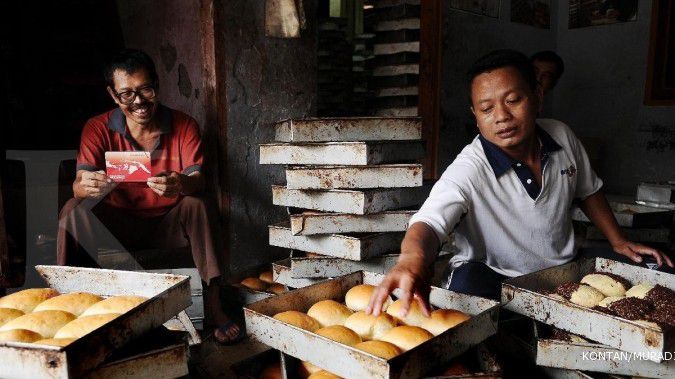JAKARTA. With a new regulation in place, foreign and joint-venture banks are obliged to expand out of their comfort zone into a much smaller playing field: the small and medium enterprise (SME) world. Banks have to increase their SME credit to at least 20 percent, no mean feat for banks that rely heavily on corporate and consumer loans.
To ensure big banks’ participation in the SME sector, last January Bank Indonesia (BI) issued a regulation, instructing all existing banks to channel a minimum of 20 percent of their total loans to the sector by 2018. BI classifies an SME as a business whose net annual turnover is less than Rp 50 billion (US$5.14 million).
There are several implementation phases. Between 2013 and 2014, banks have the freedom to lend as best as they can, but are required to have made at least 5 percent of their loans to SMEs in 2015. The threshold is increased by 5 percent each following year until the 20 percent target is achieved in 2018.
The BI reckons that of the Rp 2,779 trillion lending throughout 2012, about 19.9 percent or Rp 552.2 trillion went to 9.1 million SME accounts, including the micro segment.
This may seem like a lot but to a BI director Yohanes Santoso Wibowo, penetration into the sector was uneven from one bank to another.
“One bank has given about 44 percent of its lending portfolio to SMEs, but another bank has only made 0.2 percent available,” he said recently.
So far, trading dominates SME loans with 47.6 percent, followed by industry and agriculture with 10.9 percent and 8.1 percent, respectively.
BI will enforces the rule on foreign and joint venture banks — which are known for their big corporate loans — to maximize their contribution to the local economy since “these banks make their livings in Indonesia”.
HSBC Indonesia’s global market head Ali Setiawan said the bank actually had its own definition of an SME. Based on its unaudited December 2012 financial report to BI, HSBC’s SME loans only made up 0.5 percent of the total.
The bank is considering several options to meet the BI requirement. “We will follow BI’s SME classification and may partner with multifinance companies to channel the required loans indirectly,” he said. It will be difficult for the HSBC to carry out all processes by itself because of a lack of an SME network.
Like HSBC, Standard Chartered Bank also has its own classification of SME business. Standard Chartered’s Micha Tampubolon said that the SME market’s vast size and potential attracted the British-based bank to venture into the sector 10 years ago.
Currently focused on eight main industries, Standard Chartered classifies small businesses as those with annual turnover of up to $10 million and medium businesses with annual turnover of between $10 million and $37.5 million.
Standard Chartered active SME clients number around 3,000, who are mostly in Jakarta and Surabaya. It serves customers through its own branch offices without cooperating with other parties.
“Our SME portfolio is still very small, about 7 percent of total credit. So we have a big task on our hands, especially if we have to reclassify our SME segment to comply with BI’s standards,” he said.
ANZ Indonesia is optimistic it will reach the initial 5 percent requirement in 2015. According to ANZ commercial banking head Saud Abdul Minam, the bank will expand its existing SME business to all branches in 11 cities by the middle of this year.
ANZ launched an SME loan product last October. Its December report to BI shows these loans represented 0.1 percent of its total.
“In terms of staff, they are already there. In terms of the system, it is already there. In terms of the capability of selling the product, we are already there,” Minam said.
Commonwealth Bank Indonesia may breathe a sigh of relief since its SME loans already account for 20 percent of its total portfolio as of December. SME loans stood at Rp 1.9 trillion, rising by half from 2011.
Commonwealth claims to have adjusted its SME standards match those of BI. At the moment, the bank serves more than 2,000 SME clients in service, retail and processing industries, from 91 branch offices in 32 cities. Commonwealth president director Tony Costa expects a 40 percent increase in SME loans in 2013.
Gadjah Mada University (UGM) economist A. Tony Prasetiantono believes that even without the BI rule, banks would eventually enter the SME market, because of its excellent potential to make profits. Despite the optimism of banks, he predicts that they will face a hard time meeting the target due to the large volume of loans concerned.
“That is a lot of money to channel. It will take longer for the rule to be implemented effectively. We cannot move in haste because there is a risk of a rising non-performing loan ratio,” he added.
Another economist, A. Prasetyantoko from Jakarta’s Atma Jaya Catholic University, expects that some banks will fail to meet the target. He applauds BI’s decision to be lenient on foreign and joint-venture banks by incorporating their allocated export loans for non-oil and gas sectors into SME loans.
“That is one way to solve capacity differences among banks. Just like SME loans, we need to expand export loans,” he said.
Foreign, joint venture banks gear up for SMEs
April 01, 2013, 10.13 AM
/2011/03/23/2127178019p.jpg)
ILUSTRASI. Perawatan Kulit Pria
Source: Jakarta Post
| Editor:
Latest News
-
December 29, 2025, 10.13 PM
Wall Street Falls as Tech Rally Falters in Final Week of 2025
-
December 29, 2025, 02.23 PM
Asian Stocks Rise, Precious Metals Hit Records on Fed Rate Cut Bets
-
December 27, 2025, 04.19 PM
Moscow Sentences Russian Diplomat to 12 Years for Passing Secrets to U.S Intelligence
-
December 24, 2025, 05.47 PM
MGMC 2025 Highlights Moscow’s Global MICE Readiness—Can Indonesia Follow?
-
December 24, 2025, 05.17 AM
GLOBAL MARKETS-Equities Rise after Strong US Data, Yen Firms on Currency Warnings
-
December 23, 2025, 02.06 PM
Indonesia Expects Normal Wet Season in 2026, Weather Agency Says
-
December 23, 2025, 01.22 PM
GLOBAL MARKETS-Stocks, Precious Metals Rise; Yen on Intervention Watch
-
December 23, 2025, 11.14 AM
Indonesia Eyes US Tariff Deal Signing in January, Says All Issues Settled
-
December 23, 2025, 09.48 AM
Indonesia Trade Negotiator Says All Substantial Issues Settled with U.S.














